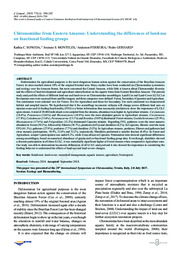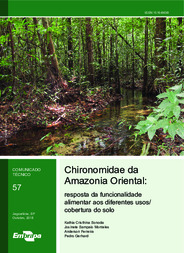Scientists use aquatic mosquito larvae as environmental bioindicators
Scientists use aquatic mosquito larvae as environmental bioindicators
Photo: Atelopus/ iStock

Aquactic insects present in the water point to conservation or degration of the site
Researchers from Embrapa and from the Federal University of Greater Dourados (UFGD), in a study conducted in the Amazon region, discovered that changes in the dietary patterns of a family of aquatic insects (Chironomidae Diptera), which is present in small bodies of water in the Eastern Amazon, can work as an important indicator of environmental changes caused by agricultural activity.
It was the first time that the consequences of different land uses and soil covers were assessed using such insects. Because such animals can have a higher or lower sensitivity to pollution and changes in their environment, as they need specific conditions to develop, they indicate to scientists the extent and intensity of environmental impacts in an aquatic ecosystem and in the watershed. For that purpose, factors like the presence of insects, their amount, distribution and dietary behavior are analyzed.
The study revealed that the streams in forest environments showed a more stable aquatic assembly (group of insects), whereas those found in areas with agriculture proved to be less diverse and functional.
The differences observed in the dietary dynamics of the insect communities are related to the impacts of land use and soil cover, evidencing the close relationship between the deforestation of areas of riparian forest for agricultural purposes and the changes in the insects' diet.
A heavyweight familyChironomidae is generally the most abundant family of macroinvertebrates in aquatic ecosystems of the whole world, and it plays an important ecological role, either as prey, as food source for natural predators, or by regulating other populations by behaving like predators. It also helps in the conversion of organic matter into available animal protein. |
An important factor of the impact of agriculture observed on the aquatic macroinvertebrate communities was more intense sedimentation in streams by pastures than in forest ones, which significantly reduces the abundance of shredders. In other words, this type of insect is found in lower amounts in waters that go past deforested areas.
On the other hand, the study identified more stable communities in forest streams, with higher participation of filter-feeders and collector/gatherer insects, while aquatic communities in agricultural areas showed a greater presence of predator insects.
The shredders are directly related to the availability of organic matter, which, in the study, had significant presence in forested streams.
As the Embrapa Environment researcher Kathia Sonoda stresses, the refined results strengthened previous studies, which reported the negative effects of agricultural systems in the degradation of streams. According to her, these studies showed the importance of the Chironomidae family' behavioral changes (see box) in the community due to increases in agricultural areas. That is, the lesser the interference in the environment, the greater the balance in the communities of aquatic insects.
Moreover, the researcher reports that, due to presence of genera that are sensitive and resistant to environmental change, these insects are good indicators of the quality of the environment. “Despite its abundance and diversity in different neotropical aquatic environments, this family still lacks many studies in terms of systematics, biology, ecology and behavior, besides the training of a higher number of professionals dedicated to study it”, ponders the Embrapa scientist.
The research
Four areas were selected for the study sampling, two in the Marapanim river basin, the other two in the Capim and Guamá river basins, both in Pará state. A total of 20,884 individuals in ten streams were sampled, comprising 64 genera, most of which (37) of the Chironominae subfamily. "The results corroborate different recent studies demonstrating the importance of the preservation, conservation and recovery of riparian forests ”, reveals Anderson Ferreira, professor of the Federal University of Greater Dourados (UFGD). “Changes to riparian ecosystems lead to the disruption of the waterways, especially the loss of habitats, and affect the whole food chain for all aquatic organisms. Our results coincide with studies that demonstrate that land use and cover in the rest of the river basins also present deleterious effect to aquatic ecosystems", he asserts. |
Biomonitoring as a soil management tool in the Amazon
According to the Embrapa researcher Kathia Sonoda, biomonitoring can be used in sustainable soil management in Eastern Amazon. “Would it be an important contribution for the maintenance of local forests on a macroscale, and this is relevant to the extent that the preserved Amazon forest contributes to the stability of the rain regimen in the other regions of Brazil and in neighboring countries, in light of the 'flying rivers' phenomenon.”
The flying rivers are “atmospheric bodies of water ” formed by air masses and water vapor, followed by clouds and driven by the winds. Such invisible chains travel long distances taking the humidity from the Amazon Basin to Brazil's Midwest, Southeast and South to fall again as rain.
Kathia Sonoda warns that rainfall in the La Plata River basin can be reduced due to deforestation in the Amazon Rainforest and that “this process can significantly affect agricultural production in Brazil and in another four countries in the South of South America”, the scientist foresees.
In order to guide management strategies aiming at the conservation of the aquatic biome considering soil exploration, it is important to also consider the influence of changes to the development of the river basins and to the kind of pasture management, as those under rotation are associated with higher stability on the edge of streams, higher quality of aquatic habitat, lower levels of soil compaction and greater particles at the bottom of the stream.
For Sonoda, an important factor of the impact of agriculture observed on the aquatic insects communities is more intense sedimentation in streams by pastures than in forested ones. She explains that this factor promotes a significant decrease in the abundance of shredders, something that was observed in the study.
The presence of shredders is a relevant way to analyse the environment, as they are associated with the presence of vegetation from other areas, which indicates that it is a place with high level of conservation of riparian forest.
According to the researcher, understanding the impact of land use and cover on the aquatic entomofauna (insects) is a fundamental stage for rehabilitation projects. “Aquatic biomonitoring is a scientific field that can reflect the quality of a studied system in real time, and thus it has received a lot of attention from the world's scientific community in the last few decades", the scientist observes.
Check the full study published as a technical communication available online. Besides Sonoda, other research participants are Josinete Monteles, a freelance oceanographer; Anderson Ferreira, an assistant professor at UFGD; and Pedro Gerhard, a researcher from Embrapa Territorial Intelligence.
Translation: Mariana Medeiros
Marcos Vicente (MTb 19.027/MG)
Embrapa Environment
Press inquiries
meio-ambiente.imprensa@embrapa.br
Phone number: +55 19 3311-2608
Cristina Tordin (MTb 28.499/SP)
Embrapa Environment
Press inquiries
meio-ambiente.imprensa@embrapa.br
Phone number: +55 19 3311-2608
Further information on the topic
Citizen Attention Service (SAC)
www.embrapa.br/contact-us/sac/



